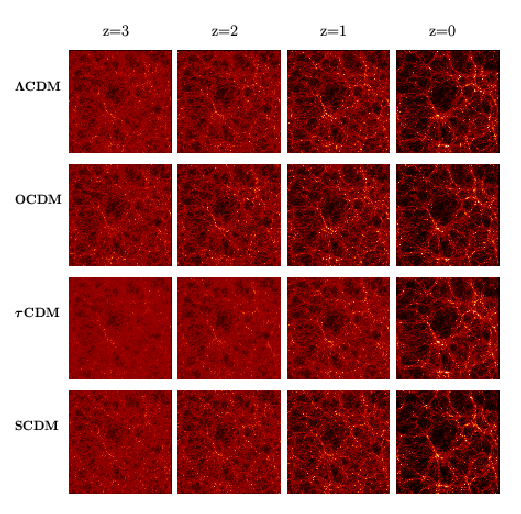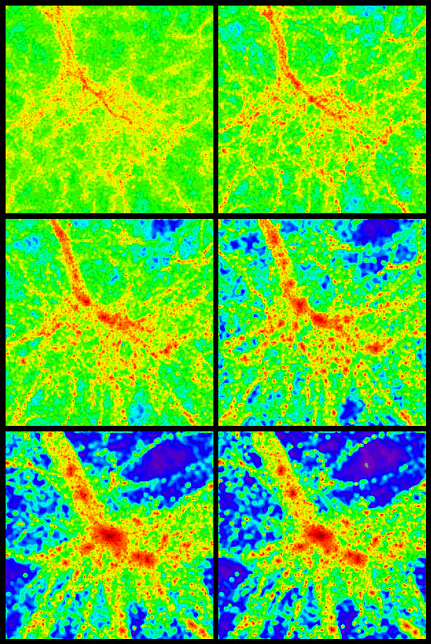|
Higher resolution simulations in smaller boxes
|
introduction/
sim. parameters/
reference/
data-download
|
Introduction: Formation and Evolution of Large Scale Stucture |
 Pic.1 This picture shows projected dark-matter distribution in four
different model universes. It also shows the time evolution
along horizontal sequence in each row.
The cosmological parameters are the same as in
the Virgo simulations for each model and the number of
particles is also 2563, but the box size is smaller.
Thus these simulations have higher mass resolution.
Pic.1 This picture shows projected dark-matter distribution in four
different model universes. It also shows the time evolution
along horizontal sequence in each row.
The cosmological parameters are the same as in
the Virgo simulations for each model and the number of
particles is also 2563, but the box size is smaller.
Thus these simulations have higher mass resolution.
Credit: Kauffmann, Colberg, Diaferio, and White, ref.1
| Model | Omega0 | lambda |
h | Gamma | Sigma8 | Npar |
L (Mpc/h) | mp (M_sun/h) | l_soft (Kpc/h) |
| SCDM | 1.0 | 0.0 |
0.5 | 0.50 | 0.6 | 2563 |
84.5 | 1.0 x 1010 | 36 |
| tCDM | 1.0 | 0.0 |
0.5 | 0.21 | 0.6 | 2563 |
84.5 | 1.0 x 1010 | 36 |
| LCDM | 0.3 | 0.7 |
0.7 | 0.21 | 0.90 | 2563 |
141.3 | 1.4 x 1010 | 20 |
| OCDM | 0.3 | 0.0 |
0.7 | 0.21 | 0.85 | 2563 |
141.3 | 1.4 x 1010 | 30 |
|
Formation of Galaxy Clusters |
Pic.2 This picture shows the same cluster from the tCDM
(left panel) and LCDM (right panel) model for redshifts of 2
(top), 1 (middle), and 0 (bottom). The simulations were run with the
same phases of the intial density field but the sizes of the
regions are different: 21x21x8 (Mpc/h)3 and 35x35x13
(Mpc/h)3 for tCDM
and LCDM, respectively.

Credit: Kauffmann, Colberg, Diaferio, and White, ref.1
Reference
-
Clustering of Galaxies in a Hierarchical Universe: I. Methods and
Results at z=0, G. Kauffmann, J.M. Colberg, A. Diaferio, S.D.M.
White, 1999, MNRAS, 303, 188-206, (Preprint astro-ph/9805283)
Back to MPA/
NumCos

Last modified: Thu Jan 13 13:10:50 MET 2000
by Virgo Administrator
 Pic.1 This picture shows projected dark-matter distribution in four
different model universes. It also shows the time evolution
along horizontal sequence in each row.
The cosmological parameters are the same as in
the Virgo simulations for each model and the number of
particles is also 2563, but the box size is smaller.
Thus these simulations have higher mass resolution.
Pic.1 This picture shows projected dark-matter distribution in four
different model universes. It also shows the time evolution
along horizontal sequence in each row.
The cosmological parameters are the same as in
the Virgo simulations for each model and the number of
particles is also 2563, but the box size is smaller.
Thus these simulations have higher mass resolution.

